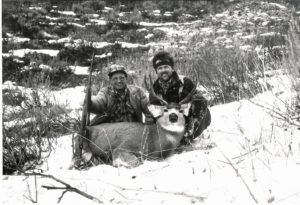 One of my hunting mentors of the 1990s was Jack Atcheson Sr., a renowned hunting consultant and taxidermist from Montana who has hunted on 5 continents and shot as many head of game as any man on earth, from Cape buffalo to elk to sheep to all the varieties of North American deer, and some big ones.
One of my hunting mentors of the 1990s was Jack Atcheson Sr., a renowned hunting consultant and taxidermist from Montana who has hunted on 5 continents and shot as many head of game as any man on earth, from Cape buffalo to elk to sheep to all the varieties of North American deer, and some big ones.
One time on a wilderness backpack hunt for mule deer, Jack told me we were going to still-hunt and stalk the entire week, and he was going to teach me how to do it.
“I’ve been hunting deer for 25 years,” I reminded him with a smirk.
“Yeah, but this week you’re gonna learn how to do it right.”
On day one, we split apart about a half-mile and still-hunted west toward our landmark, a towering crag. I arrived in an hour, sat on a log and waited.
Two hours later in creeped Jack.
“See anything?’ I asked.
“Two bucks, one a big 4-point, and a small herd of elk,” he replied. “You?” He asked that with a sly grin.
I had jumped one doe, and I got Jack’s message loud and clear.
For the next 5 days we hunted side by side, creeping up mountains and down drainages, stopping often to scan wide with our eyes and glass tighter into the cover with binoculars. Every 100 yards or so, we’d stop, turn, creep back 50 yards and re-scan the terrain where we had just come from.
 On the last day, that is how I found this buck with Jack and shot it.
On the last day, that is how I found this buck with Jack and shot it.
“Every person I’ve ever hunted with, and there have been many hundreds over the years, moves too fast and never looks back,” Jack told me. “Still-hunt as slowly as you can for 50 yards, and then slow down some more for the next 25 to 50. Stop often, always beside a tree that you can use as a rifle rest if you need it. Every once in a while, fishhook back, get a little elevation and look where you came from. You’ll see and shoot a more bucks that way.”





